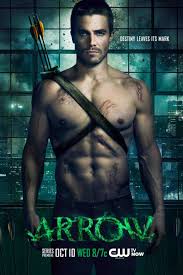Selling Arrow with Skin and Ethics

Image Credit: thegreenarrow.net
This week I’m following up on Aubri’s discussion of promotional photos for TV shows (in her post, Orange is the New Black) and my own examination of masks in Arrow. While the Arrow characters’ masks cover up more of the actors’ skin (in addition to the long sleeves and long pants of their costumes) some of the promotional imagery for the show specifically emphasizes bare skin. The image above portrays Stephen Amell playing Oliver Queen as The Arrow, but wearing only his quiver and some tight-fitting pants. Queen is frequently portrayed shirtless in the show while he is exercising or being patched up after combat, but never does he actually go out as The Arrow wearing less than his full costume including hood and mask. The image juxtaposes Queen’s identity as a vigilante hero with his sex appeal as a handsome and muscular man.
On one level, this image simply rehearses the standard formula that sex sells. However, the text in the upper right of the image emphasizes something rather different. “Destiny leaves its mark” draws attention to the scars that criss-cross Queen’s upper body. In the story, these are relics of the torture Queen underwent as part of the backstory that made him into The Arrow. Whether these scars constitute part of Queen’s attractiveness or work counter to his appeal depends on the eye of the beholder. Within the show, the character Laurel Lance sleeps with Queen, her old flame, immediately after her first time seeing his scars, suggesting that she, at least, finds him more attractive with them. Others’ mileage may vary. The emphasis on the scars may also be a nod to the show’s heterosexual male audience, who presumably wouldn’t particularly care about Queen’s bare chest without the scars that emphasize what a badass the character is.

Image Credit: wegotthiscovered.com
This picture of David Ramsey as John Diggle is even more transparently sexual, showcasing his muscles without any scars or distracting tagline. Diggle is Queen’s loyal friend and in some ways the emotional heart of the show, but he’s not the hero or any of the vigilantes who go in costume and have alternate names. Nor would the character actually ever pose like this in the show. The picture doesn’t sell the story of Arrow; it sells the body of the actor. There is a similar poster of Colton Haynes, who plays Roy Harper, so all the male members of Team Arrow have been used to sell the show in this way.

Image Credit: thegreenarrowtv.com
The above picture, by contrast, shows a clothed Oliver Queen (as far as one can tell) with his face partially obscured by an arrow. The image emphasizes the divided nature of Queen’s character – part ordinary man, part city-saving hero. It also shows the hero side as shadowed, which the tagline picks up on: “innocent and not guilty are two different things.” Since its beginnings, the show has wrangled with the ethical implications of being a vigilante. The second season features a key character transformation in which The Arrow stops killing bad guys and settles for stopping them, sometimes only temporarily. A vigilante who is not a killer is not guilty of homicide, but he is not an ordinary, innocent man either. This image actually sells the show’s ethical complexity as something attractive, a much more cerebral approach to advertising than the ones shown above.



Add new comment